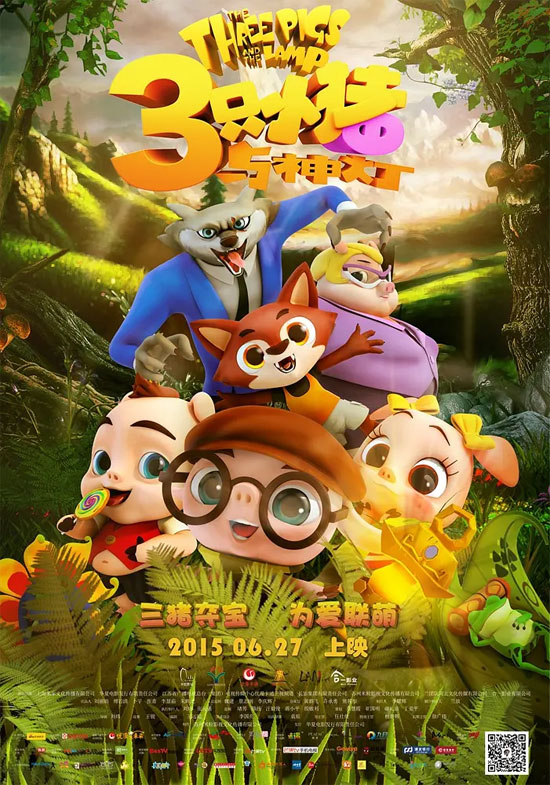Film Name: 三只小猪与神灯 / The Three Pigs and The Lamp

I believe this film does not represent the true caliber of Mili Pictures, but rather a low-budget, non-priority project.
Having watched “Happy Little Submarine Magic Box of Time” at the beginning of the month and “The Three Pigs and The Lamp” at the end, I couldn’t help but notice that “treasure hunting” has become a popular theme in domestic animated films this year. If I had to describe this treasure-hunting trend with one word, it would be “boring.” These stories follow a formulaic pattern: a few mischievous protagonists + seemingly valuable treasures + one or two obstacles + several fantastical scenes—and that’s all it takes to wrap things up.
Anyone can go on a treasure hunt, and anything can be turned into treasure. The key lies in using fantastical settings to capture children’s attention—it can lack logic, it can lack character, but it absolutely must grab attention. Because audiences have a cognitive bias when watching movies, mistakenly equating how much attention they pay with whether the film is good or not. Finally, just throw in some inexplicably sentimental stuff, and voilà—the dish is stir-fried and done. Treasure hunt films have become instant products like instant noodles, with incredibly low barriers to entry.
What should truly define a film’s quality for audiences? Attention is one factor, but not the most crucial one. What matters most is emotional investment. The “attention economy” of these treasure hunt films perfectly caters to the fast-food demands of the internet age, but they remain nothing more than fast food. Whether it’s fantastical settings or chase sequences, while they grab viewers’ attention, they lack the depth to engage them emotionally.
Perhaps “The Three Pigs and The Lamp” attempted to establish such emotional points. For instance, Xiao Mi’s reluctance to see Xiao Guang’s emotional bond with Bo exhausted. Yet this tension could only reach its peak when Xiao Guang sacrificed himself after depleting his energy—a conflict the film regrettably never fully explored (as far as I recall). Similarly, the potential friendship between Xiao Lang and the three piglets remained underdeveloped. The film’s ambiguous portrayal leaves audiences uncertain whether Little Wolf is inherently good or evil, or capable of redemption. Ultimately, it abandons this emotional thread entirely, simply banishing him to the moon. One must ask: Is Little Wolf’s role in the film truly equivalent to that of his wolf father? Was Little Wolf’s ultimate punishment truly necessary—isn’t he just a child too?
No one told Wolf Dad that the energy entity in the magic lamp was called Little Light, yet he directly summoned both Little Light and the unseen Xiaomi. The film is riddled with such logical inconsistencies. Xiaomi splits from the other two piglets mid-journey, only to reunite with them effortlessly later—meaningless plot devices like this abound throughout the film. Not only do the wolves resort to violence against the pigs, but the pigs also retaliate with various traps against the wolves. Ultimately, the film devolves into a vulgar gimmick piece that revels in deceit and trickery.
Everything remains superficial. Wolf Dad, dressed in a suit and tie, could have been a richly layered character. On one hand, he’s the king of the jungle; on the other, he hypocritically dons a suit. Was this setup meant to be merely amusing? Moreover, he embodies both savagery and paternal affection. Yet the film concludes by banishing him and his son to the moon, showing not a shred of compassion for his fatherly love and imposing a simplistic, black-and-white morality on the audience. This makes for a particularly poor viewing experience.
From the moment I learned the magic lamp could grant three wishes, I pinned my hopes on that third wish—the one that often reveals humanity and demands our deepest emotional investment. Yet after waiting over 80 minutes, it proved utterly disappointing. What an astonishingly simplistic resolution! As I recovered from my astonishment, I realized it might not be the film’s immaturity, but rather my own foolishness for harboring such expectations.
The film’s sole redeeming quality lies in its visual style. This pure-color, clay-like aesthetic, popularized by Little P Youyou, has become a globally beloved animation trend. The film maintains this international style in character modeling, color palette, and even scene and prop design, creating a soft, tactile look that invites touch. Beyond this, the film offers virtually no thematic highlights.
Please specify:Anime Phone Cases » The Three Pigs and The Lamp 2015 Animation Film Review: Treasure hunt movies are so much fun to shoot!